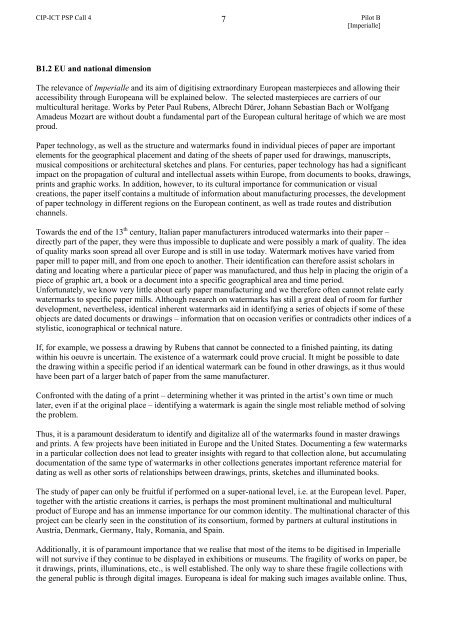proposal part b - The Bernstein Project
proposal part b - The Bernstein Project
proposal part b - The Bernstein Project
Create successful ePaper yourself
Turn your PDF publications into a flip-book with our unique Google optimized e-Paper software.
CIP-ICT PSP Call 4 7<br />
Pilot B<br />
[Imperialle]<br />
B1.2 EU and national dimension<br />
<strong>The</strong> relevance of Imperialle and its aim of digitising extraordinary European masterpieces and allowing their<br />
accessibility through Europeana will be explained below. <strong>The</strong> selected masterpieces are carriers of our<br />
multicultural heritage. Works by Peter Paul Rubens, Albrecht Dürer, Johann Sebastian Bach or Wolfgang<br />
Amadeus Mozart are without doubt a fundamental <strong>part</strong> of the European cultural heritage of which we are most<br />
proud.<br />
Paper technology, as well as the structure and watermarks found in individual pieces of paper are important<br />
elements for the geographical placement and dating of the sheets of paper used for drawings, manuscripts,<br />
musical compositions or architectural sketches and plans. For centuries, paper technology has had a significant<br />
impact on the propagation of cultural and intellectual assets within Europe, from documents to books, drawings,<br />
prints and graphic works. In addition, however, to its cultural importance for communication or visual<br />
creations, the paper itself contains a multitude of information about manufacturing processes, the development<br />
of paper technology in different regions on the European continent, as well as trade routes and distribution<br />
channels.<br />
Towards the end of the 13 th century, Italian paper manufacturers introduced watermarks into their paper –<br />
directly <strong>part</strong> of the paper, they were thus impossible to duplicate and were possibly a mark of quality. <strong>The</strong> idea<br />
of quality marks soon spread all over Europe and is still in use today. Watermark motives have varied from<br />
paper mill to paper mill, and from one epoch to another. <strong>The</strong>ir identification can therefore assist scholars in<br />
dating and locating where a <strong>part</strong>icular piece of paper was manufactured, and thus help in placing the origin of a<br />
piece of graphic art, a book or a document into a specific geographical area and time period.<br />
Unfortunately, we know very little about early paper manufacturing and we therefore often cannot relate early<br />
watermarks to specific paper mills. Although research on watermarks has still a great deal of room for further<br />
development, nevertheless, identical inherent watermarks aid in identifying a series of objects if some of these<br />
objects are dated documents or drawings – information that on occasion verifies or contradicts other indices of a<br />
stylistic, iconographical or technical nature.<br />
If, for example, we possess a drawing by Rubens that cannot be connected to a finished painting, its dating<br />
within his oeuvre is uncertain. <strong>The</strong> existence of a watermark could prove crucial. It might be possible to date<br />
the drawing within a specific period if an identical watermark can be found in other drawings, as it thus would<br />
have been <strong>part</strong> of a larger batch of paper from the same manufacturer.<br />
Confronted with the dating of a print – determining whether it was printed in the artist’s own time or much<br />
later, even if at the original place – identifying a watermark is again the single most reliable method of solving<br />
the problem.<br />
Thus, it is a paramount desideratum to identify and digitalize all of the watermarks found in master drawings<br />
and prints. A few projects have been initiated in Europe and the United States. Documenting a few watermarks<br />
in a <strong>part</strong>icular collection does not lead to greater insights with regard to that collection alone, but accumulating<br />
documentation of the same type of watermarks in other collections generates important reference material for<br />
dating as well as other sorts of relationships between drawings, prints, sketches and illuminated books.<br />
<strong>The</strong> study of paper can only be fruitful if performed on a super-national level, i.e. at the European level. Paper,<br />
together with the artistic creations it carries, is perhaps the most prominent multinational and multicultural<br />
product of Europe and has an immense importance for our common identity. <strong>The</strong> multinational character of this<br />
project can be clearly seen in the constitution of its consortium, formed by <strong>part</strong>ners at cultural institutions in<br />
Austria, Denmark, Germany, Italy, Romania, and Spain.<br />
Additionally, it is of paramount importance that we realise that most of the items to be digitised in Imperialle<br />
will not survive if they continue to be displayed in exhibitions or museums. <strong>The</strong> fragility of works on paper, be<br />
it drawings, prints, illuminations, etc., is well established. <strong>The</strong> only way to share these fragile collections with<br />
the general public is through digital images. Europeana is ideal for making such images available online. Thus,









